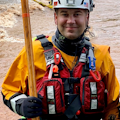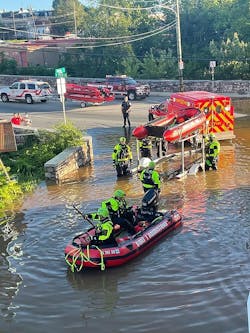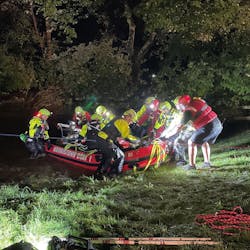After a hurricane passes through a town and streets flood, not every rescue can be completed by responders wading in floodwaters or by high-water vehicles. Boats are a water-rescue mainstay, but the urban environment presents many hazards for the team that uses the craft to save civilians. Water dynamics might mimic those of a river, but they can be faster and more perilous around structures, such as fences, vehicles and houses.
Training and equipment that are specific to the urban environment ensure that boat operators and crew are able to perform at the peak of their abilities.
Urban-specific equipment
Rescue boats require specialized items and basic modifications to adeptly respond to urban flooding emergencies.
Boats should be outfitted with a wide range of gear, including items that meet the U.S. Coast Guard’s requirements as well as the standards of the local authority having jurisdiction. However, an example of a basic modification would be putting high-visibility tape or paint on wading poles at the depth that the boat motor hangs below the boat. At low speed, you can use the poles off of the front of the boat to ensure that the water depth isn’t too shallow for the motor.
When using sharp and pointed tools, be aware of the puncture hazard for inflatable boats and protect accordingly.
Proper PPE, including gloves and eye protection, might not be front of mind during a water rescue. However, wearing gloves that provide cut and impact protection will save you from open wounds and floodwater wound contamination.
Ladders might be needed to rescue people from windows and roofs. However, most fire service ladders are too large to be transported on the average swiftwater rescue boat. Collapsible ladders that have rubberized feet are very useful.
When setting up the ladder in the boat for a rescue, it’s important to stabilize the boat against a building. This can be done by having two rescuers hold onto the building at the bow and stern or by using a support boat to push the main boat against the building at a low throttle. Don’t tie your boat to anything, in case you must leave the area quickly.
Props and horsepower
Boats are delivered with light-duty propellers unless otherwise specified. These propellers are good for higher speed but have issues with cavitation (formation of vapor bubbles) and torque. Upgrading the propeller to medium-duty increases torque and helps with cavitation issues. Having substantial torque as soon as you throttle up helps a team to get out into faster current, maintain position and avoid being pushed downstream into hazards.
Having the correct propeller/motor horsepower combination increases a boat’s capability to handle swifter currents. That said, an experienced operator who can evaluate water velocity—and the horsepower that’s needed to overcome that velocity—is vital to a successful operation.
Urban boat launch
A traditional angled boat ramp usually allows boats to float off of a trailer. The urban rescue environment lacks this ideal condition for launching a boat.
Street launches can become hazardous for a variety of reasons. One of the more frequent hazards concerns the depth of the water in relation to the vehicle that’s pushing the trailer. In other words, you don’t want to flood the vehicle. Submerging the vehicle up to the bottom of the exhaust pipe generally is the deepest that a vehicle should go.
Once a boat is launched, a driver of the vehicle should be kept on shore to monitor the water level in case it rises or if the trailer must be moved to launch more boats.
Sometimes, you’ll be unable to get the boat trailer into sufficiently deep water, or the water will be too far from where you can position the trailer. In these cases, the boat must be deployed by lifting and carrying it to the launch point. Several boats that are on the market have wheels that attach to the transom. These wheels support the heaviest end of the boat for transport across the ground. Alternatively, a portage cart (traditionally used by kayakers and canoers) can be attached under the transom of the rescue boat with webbing straps. This cart allows the boat to be transported across the ground by as few as two rescuers. Once the boat is floating, the webbing straps and cart can be removed.
A high-water vehicle can be used as a boat launch platform. Such a vehicle becomes a mothership of sorts, allowing boats to travel into the swift currents to perform the rescue and then to return to the vehicle to drop off survivors. The high-water vehicle can be backed into still water, so the boat floats off of the tailgate. Upon return, the boat can be unloaded directly into the vehicle bed.
A high-water vehicle can prevent both the boat crew from having to walk the boat in shallow water and survivors from having to walk through floodwater.
Boat-based vs. boat-assisted
Once a boat is launched, you will perform a boat-based or boat-assisted operation.
Boat-based operations always keep rescuers and survivors inside of the boat. Boat-assisted operations have rescuers walk alongside of the boat with survivors and equipment inside. Evaluating water dynamics and operational considerations dictates which style of operation is conducted.
Boat-based operations
Navigation through the urban environment can be difficult, because there are many hazards to steer around. Objects that float downstream are obvious dangers; submerged hazards, such as fences, guard rails and vegetation, might be less noticeable. You can use telephone poles or the roofs of vehicles that are along the side of a street to find the path that’s clearest from submerged obstructions.
Boats should be operated at slower speeds when navigating around houses to avoid creating wake. Wake could further damage property, put more water into a house and cause survivors to lose balance while they float on an object.
Swiftwater rescue technicians should be proficient in rope operations. Water dynamics might prevent a wading rescue, or the water might be too shallow for motor operations.
A moveable control point or a two- or four-point boat tether can be used when motors aren’t warranted. Lowering a boat to a survivor might be safer than putting rescuers in the water.Rope systems need a larger team to operate the lines that are required to control the boat.
Paddling is an important skill. Still water, descending the current and an emergency to get to an eddy are situations in which paddling can be used as the primary boat control.
Proficiency in paddling requires practice and repetition. Training should start in calm water and progress to conditions that are similar to those that are encountered on a real-world rescue. (Whitewater rafting is an enjoyable and useful training opportunity.)
Skilled paddle strokes in conjunction with a rope system that’s attached to the boat greatly improves one’s ability to steer the boat. It helps you to move through eddy lines and in and out of current and to guide the boat closer to a survivor.
Accessing survivors in still or slow-moving shallow water can be difficult with a motor. In this case, it’s optimal to use two rescuers who have proficient paddle skills in the boat. This approach keeps rescuers and survivors out of contaminated water.
Boat-assisted operations
Boat-assisted rescues are best in slow or nonmoving water that’s no deeper than the waist of rescuers. Survivor conditions should determine whether a boat is needed for transport instead of walking the survivor out of the water. Best practice doesn’t expose unprotected survivors to hazardous water.
Rescuers who perform a boat-assisted operation should walk in front of and alongside of the boat. Rescuers who are in front should be a few yards ahead of the boat and have wading poles to test the ground ahead, checking for elevation changes, open street maintenance hole covers and submerged objects and ensuring that the path is intact. These rescuers should be in line with those who are holding onto the boat. Rescuers who guide the boat must hold on to pull the boat forward and use the boat as a support to prevent them from falling.
Managing the weight of survivors and equipment that’s carried in the boat is an important consideration. Too much weight makes it difficult to pull the boat through water. It also increases the chances to run aground. Manufacturer recommendations and information on the transom plate provide maximum allowable weights, but conditions might dictate a lower maximum.
Remaining vigilant about water conditions is essential. When navigating roadways, the water will be deeper along the side and shallower in the middle. This is because of the crest of the roads. Preplanning and using Google Street View (see “Mapping Software” at left) can show elevation changes to let you know where rescuers would float instead of walk. If rescuers begin to float, a transition to a boat-based rescue is necessary. Water velocity also can change during the course of a rescue, which could cause the force against the boat to increase. Constant evaluation of hydraulics is required for safe navigation.
Prep for the threats
Urban flooding brings many threats to personnel and boats that must be identified, assessed and mitigated. Proper boat operations require training, practiced techniques and critical-thinking. These assets, while maintaining vigilance in an ever-changing environment, will position your team to achieve the best possible outcomes.
Mapping Software
Performing a good scene size-up amid urban flooding might be difficult, depending on the water level. Google has a great feature on its mapping software, called Street View. Street View can show a crew how an area is laid out, where hazards might be, the easiest path of travel and other general information. Although the pictures on Street View might be dated slightly, they usually will be close enough for your needs.
About the Author

Andrew McIntyre
Andrew McIntyre has been in the fire service since 2003, serving in both career and volunteer departments, on urban search and rescue teams, and as an instructor. Further work as a whitewater river guide, ski patroller, scuba divemaster and mountaineer brings a wide range of knowledge and experience. McIntyre is a U.S. Marine Corps. infantry veteran.


